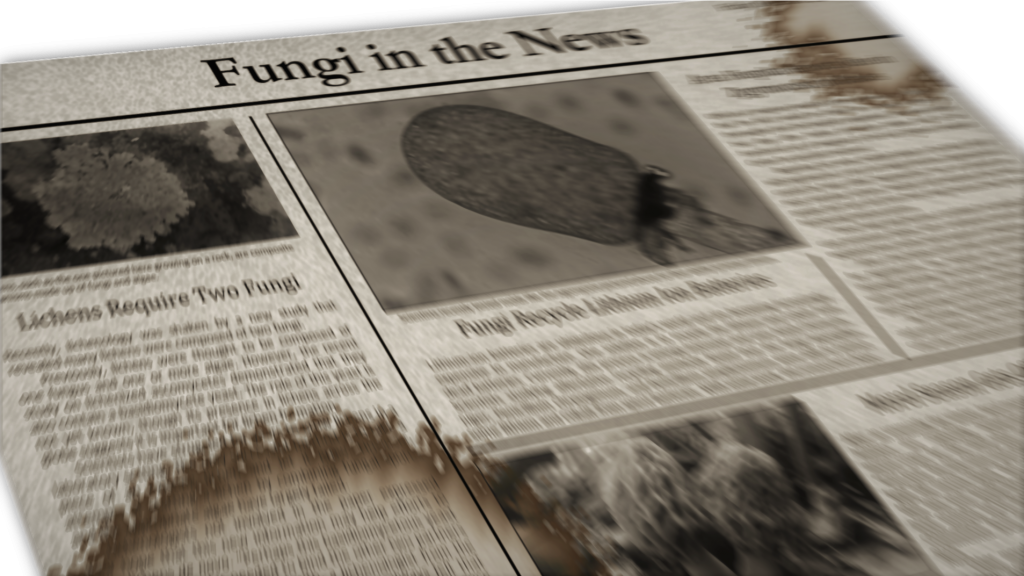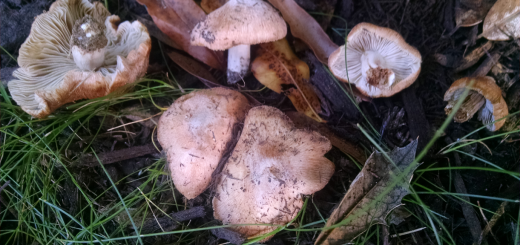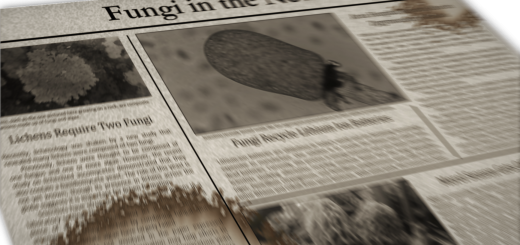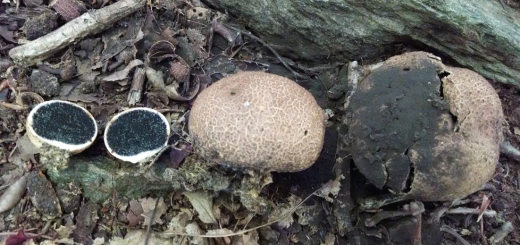Mycology News: April to June 2016

Fungi appear in the news with surprising frequency. However, many of those stories do not provide any new information. Below is a summary of what we’ve learned about fungi from November 2016 Through February 2017. Read below to learn about: mycorrhizas, A. bisporus engineering, fungal evolution, psilocybin research, fungal concerns in medicine, rock-eating fungi, and more! Visit the associated links to get the full story.
With the growing concern over untrustworthy news sources and the media’s tendency to inaccurately report scientific studies, can these sources be trusted? Yes they can, with a bit of caution. I have checked to make sure all the articles based on scientific papers draw from peer-reviewed journals and that they accurately reflect the content of the papers. For articles not linked to scientific papers, I try to stick to sources with a good track record in reporting on science or to local sources for region-specific information. However, I encourage you to do your own research and decide for yourself whether these sources are trustworthy.
Mycorrhizae Follow Economic Principles
The basic principle of mycorrhizae (fungi trade their nutrients like potassium for a plant’s sugars from photosynthesis) gets much more complicated when a plant forms mycorrhizae with multiple fungi. Researchers discovered that when a plant was connected to two mycorrhizal fungi, one of which demanded more sugars in exchange for its resources than the other, the plant would supply all fungi with the amount of sugar given to the most generous fungus. This forces the stingier fungus to pay more nutrients per unit sugar than it would normally or else be starved out. This is very similar to the way economic systems function, suggesting that mycorrhizae can be used as models for studies in economic decision-making. Read more at: http://phys.org/news/2016-04-fungal-partners.html
Genetic Engineering of Agaricus bisporus
A Pennsylvania State University researcher has used the CRISPR/Cas9 gene editing technique to create a variety of the white button mushroom (Agaricus bisporus) that turns brown much more slowly. bisporus normally develops a brown color when it is injured and as it ages. Consumers tend to throw away mushrooms that have turned brown, so reducing browning can increase shelf life and allow the use of automation in the harvesting process. In the new variety, genes responsible for browning were deactivated using the CRISPR/Cas9 system. This highly-accurate genetic manipulation system was used to modify the fungus’s genes without introducing any foreign DNA. A. bisporus is the first crop to be modified using this technique. The U.S. Department of Agriculture (USDA) currently regulates only crops that have been modified to include DNA from other organisms. Consequently, the mushrooms can be produced and sold to consumers without having to comply with the USDA’s regulations for genetically modified organisms. Read more at: http://www.nature.com/news/gene-edited-crispr-mushroom-escapes-us-regulation-1.19754 and https://www.washingtonpost.com/news/speaking-of-science/wp/2016/04/18/why-this-genetically-modified-mushroom-is-bypassing-usda-regulation/
Viral Genes and Rise of Fungi
Researchers at Duke University and Stanford University suggest that the fungal cell cycle is controlled by genes stolen from ancient viruses. Plants and animals have very similar genes for controlling cell growth and division. Fungi, however, have proteins that perform the same function but are based on radically different genes. These fungal genes are most similar to ones found in viruses. This suggests that the genes may have been picked up from a virus that infected an early fungus. Viruses often carry genes that force their host cells to divide more quickly, which results in the production of more viruses. An ancient fungus likely incorporated some of the viral genes into its own genome, where they gradually replaced the native cell cycle genes. Read more at: http://today.duke.edu/2016/05/hijackedfungi
Psilocybin May Help Treat Depression
A trial at Imperial College London found that psilocybin – the hallucinogenic compound found in “magic mushrooms” – was able to provide temporary relief from symptoms of depression in moderately and severely depressed patients. The 12 patients involved in the trials were given a very high dose of psilocybin along with psychological support and eight were not depressed after the hallucinogenic effects wore off. Three months later, five of the patients were still not showing signs of depression. Although the results are encouraging, the study consisted of a mere 12 individuals and neglected to include a placebo group. Psilocybin is a highly-regulated drug in both the United States and the United Kingdom, which makes it difficult for researchers to perform trials like this one. Despite this, the study’s authors hope to follow up their research with larger trials in the future. Read more at: http://www.bbc.com/news/health-36247599
Smart Slime Molds
A recent study using the plasmodial slime mold Physarium polycephalum examined the ability of single-celled organisms to make rational decisions by using a modified “two-armed bandit” test. The slime mold was given a choice of two directions to explore, each with food spaced at regular intervals. One direction, however, contained more patches of food than the other. The slime mold would first explore both directions before switching to a single direction. Most often, polycephalum would choose to stop exploring the direction with less food and focus its energies in the direction with more food. The cellular machinery that allows P. polycephalum to make rational decisions is not yet understood. Read more at: http://www.njit.edu/features/innovations/garnier-slime-mold.php
Fungal Enzyme’s Structure Solved, May Allow Creation of New Antifungals
Duke University scientists have visualized the structure of the fungal Tps2 protein, which is involved in the trehalose synthesis pathway. Trehalose is a type of sugar that helps pathogenic fungi survive the high temperatures found in the human body. Tps2 is the final enzyme in the pathway that creates trehalose. Using DNA sequencing and X-ray crystallography, the researchers were able to visualize the structure of Tps2. They found that the functional areas of Tps2 were essentially identical in the most common pathogenic fungi. The authors hope that knowing the protein’s structure will aid in the development of a new class of antifungal drugs that prevent Tps2 from working. Read more at: http://today.duke.edu/2016/06/antifungal
Helpful Fungi Regulate Immune System
Researchers at Weill Cornell Medicine demonstrated that healthy mice treated with antifungals reacted more severely to gut and lung irritants. It is now known that the human body harbors many bacteria that are beneficial to health. Unfortunately, not much is known about the fungi living inside humans. The team from Weill Cornell Medicine decided to test whether or not these fungi impact health by using mice as a model organism. Healthy mice were given antifungals to kill any fungi living in their bodies. Then, they were given irritants that caused inflammation in the gut and lungs. The mice treated with antifungals were found to have more severe inflammation in both the gut and lungs than untreated mice. These results suggest that fungi are important for regulating the immune system and maintaining a healthy body. Read more at: http://www.news.cornell.edu/stories/2016/06/intestinal-fungi-may-aid-relief-inflammatory-disease
Ancient Termites Farmed Fungi
Scientists working in East Africa have unearthed fossilized remains of 25 million-year-old termite nests that show evidence of fungus farming. Some modern termites have special areas in their nests called “fungus gardens” where they bring plant material to be digested by a cultivated fungus. The fungus turns the otherwise indigestible plant material into food that the termites can eat. Evidence of fungus gardens was found in the recently unearthed fossils, indicating that the relationship was well-established 25 million years ago. The age of the fossils backs up DNA analysis, which had previously indicated that termites began farming fungi about 25-30 million years ago. Read more at: http://www.nsf.gov/news/news_summ.jsp?cntn_id=138928&
Yartsagumba Harvest Down
Yartsagumba is the mushroom produced by Ophiocordyceps sinensis and is valued in China and elsewhere as an aphrodisiac. Harvested only in the Tibetan Plateau, the tiny mushrooms can cost over $50,000 per pound. Unfortunately, the yartsagumba harvest has been decreasing in recent years, endangering the livelihood of many people in that region. Mycologists studying sinensis suspect that overharvesting and climate change are responsible for the decrease in production. Read more at: http://www.nytimes.com/2016/06/27/world/asia/himalayan-viagra-climate-change.html?_r=0
Deadly Yeast Spreading
The Centers for Disease Control and Prevention (CDC) warned health centers in the United States to watch for Candida auris, a pathogenic yeast that is resistant to common antifungals. auris grows and spreads easily in hospitals and infects patients. Unfortunately, most U.S. hospitals do not have the ability to readily identify this species of Candida. While the organism has not been definitively identified in the U.S., the CDC warned that it will likely spread to America. Read more at: https://www.washingtonpost.com/news/to-your-health/wp/2016/06/29/a-deadly-drug-resistant-yeast-infection-is-spreading-around-the-world/
Plants’ Response to Climate Change Determined by Mycorrhizae
Research into how plants respond to climate change has returned mixed results over the years. A new study suggests that plants react differently primarily because of their mycorrhizal fungi. Arbuscular mycorrhizal fungi are less efficient at extracting nitrogen from the soil than are ectomycorrhizal fungi. Plants need nutrients in order to remove carbon dioxide from the atmosphere. As a result, arbuscular mycorrhizal plants cannot take advantage of extra atmospheric carbon. Ectomycorrhizal-associated plants, on the other hand, can remove extra carbon. Different ecosystems, therefore, have different capacities to absorb CO2. Understanding how different plants react to increased carbon dioxide will help researchers develop more accurate models to predict climate change. Read more at: http://www3.imperial.ac.uk/newsandeventspggrp/imperialcollege/newssummary/news_30-6-2016-12-25-24
Fungi Break Down Rocks
A new study looks at the mechanism that fungi use to extract nutrients from rocks. Researchers looked at the fungus Talaromyces flavus and its ability to remove iron from a rock called lizardite. flavus initially used a combination of acids to erode the rock and extract nutrients. When the surface ran out of nutrients, the fungus used acid and physical force to dig thin channels into the rock itself. Using this research, the authors of this study estimated that 40-50% of biological weathering of rock is caused by fungi, which is much greater than the older estimate of 1%. Read more at: https://eos.org/articles/using-acid-and-physical-force-fungi-burrow-through-rock









![#011: Characteristics of Kingdom Fungi [Archived]](https://www.fungusfactfriday.com/wp-content/themes/hueman/assets/front/img/thumb-small-empty.png)
